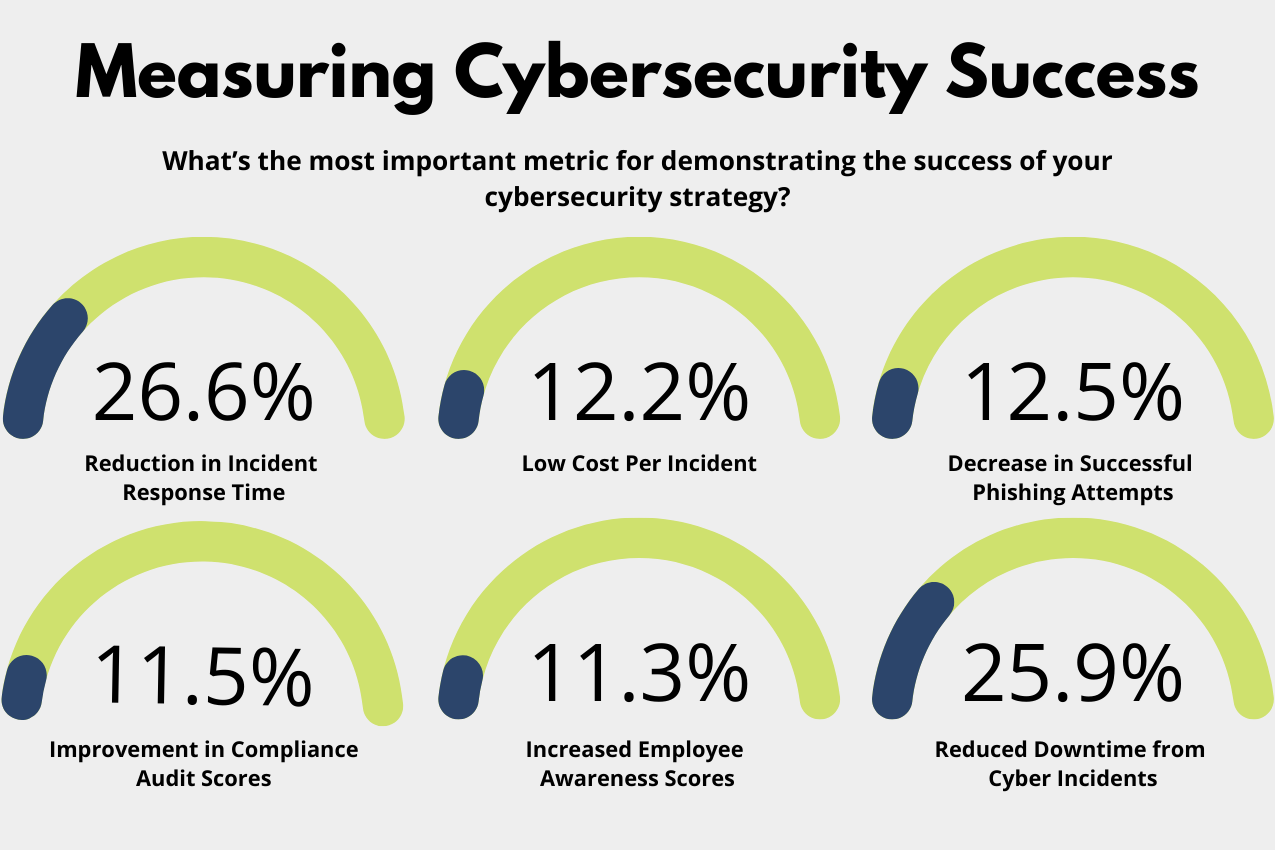As cyber threats continue to escalate in both volume and sophistication, technology leaders are re-evaluating how they measure the success of their cybersecurity strategies. It’s no longer sufficient to simply check compliance boxes or measure static risks, today’s technology leaders are prioritizing metrics that reflect real-time agility and business continuity.
To better understand these evolving priorities, The National CIO Review conducted a survey asking: What’s the most important metric for demonstrating the success of your cybersecurity strategy?
The results offer valuable insights into the mindsets of technology executives and how they’re steering their organizations toward a future defined by resilience and speed.
Reduction in Incident Response Time: The Clear Front-Runner (26.61%)
Leading the survey, with 26.61% of the total votes, is the reduction in incident response time.
This result is no surprise in an environment where the window between breach detection and containment can determine the scale of damage.
For technology leaders, faster response times equate to minimized risk exposure and lower potential financial and reputational costs. A quick reaction prevents threat actors from laterally moving across systems, extracting sensitive data, or deploying ransomware payloads.
Organizations focusing on this metric often invest heavily in automation, AI-driven threat detection, and well-practiced incident response playbooks. By prioritizing speed, they reduce the impact of cyber events and enhance confidence across stakeholders, from boardrooms to customers.

Reduced Downtime from Cyber Incidents: A Close Second (25.89%)
Nearly tying for the top spot, reduced downtime from cyber incidents captured 25.89% of votes, underscoring its importance to technology leaders.
Downtime translates directly to lost revenue, operational disruption, and customer dissatisfaction.
Whether it’s a halted supply chain, frozen customer portals, or unavailable critical infrastructure, the ramifications can be severe and far-reaching.
Leaders prioritizing this metric are doubling down on resilient architectures, disaster recovery solutions, and business continuity planning. Cloud redundancy, rapid failover systems, and proactive maintenance routines become cornerstones of their cybersecurity posture.
For industries with stringent uptime requirements, such as healthcare, finance, or utilities, this focus ensures that essential services remain operational, even in the face of cyber adversity.
Decrease in Successful Phishing Attempts: Defending the Human Perimeter (12.53%)
Coming in third, with 12.53%, is the decrease in successful phishing attempts, a clear acknowledgment of the ongoing risks tied to human error.
Phishing remains one of the most common and effective tactics used by attackers to gain initial access to systems. For technology leaders, reducing these incidents is a sign of both technological and cultural success: robust email security measures complemented by effective employee awareness campaigns.
Organizations that see improvements here typically invest in simulated phishing exercises, frequent security training, and multi-layered email defenses. It’s a metric that reflects both progress in employee vigilance and the effectiveness of technological safeguards.
While not as dominant as speed or uptime, this human-centric measure continues to play a vital role in the broader cybersecurity ecosystem.
Lower Cost Per Incident: A Practical Financial Lens (12.17%)
Earning 12.17% of responses, lower cost per incident remains an important, though slightly lower-ranked, metric. Technology leaders appreciate the direct link between improved cybersecurity postures and financial efficiency.
Reducing the cost of incidents typically follows improvements in other areas like faster response times and reduced downtime. Fewer resources spent on prolonged investigations or extensive remediation means tangible savings for the organization.
For technology leaders reporting to boards focused on ROI, this metric provides clear, digestible evidence of cybersecurity value, a crucial factor in justifying ongoing investments in security tools, personnel, and services.
Improvement in Compliance Audit Scores: Meeting the Baseline (11.46%)
With 11.46%, improvement in compliance audit scores reflects an understanding that regulatory adherence is a foundation of cybersecurity, if not the pinnacle.
While compliance alone doesn’t guarantee security, it does establish essential practices and accountability structures. Industries governed by strict frameworks (such as healthcare’s HIPAA or finance’s SOX) place significant weight on passing audits and reducing findings.
However, as the poll suggests, compliance is increasingly viewed as table stakes, a baseline expectation rather than a leading measure of success.
Increased Employee Awareness Scores: Building a Security Culture (11.34%)
Closing out the survey, at 11.34%, is increased employee awareness scores. While it ranked lower than other metrics, its importance cannot be overlooked.
Technology leaders understand that creating a security-aware culture reduces the likelihood of successful social engineering attacks and insider threats. Regular training, gamified learning experiences, and leadership engagement help improve these scores over time.
A security-savvy workforce acts as the first line of defense, complementing technical controls and reducing overall organizational risk.
The Wrap
The survey results paint a clear picture that for today’s technology leaders, the gold standard of cybersecurity success lies in operational resilience and speed. Metrics like incident response time and downtime reduction dominate executive priorities, reflecting a practical shift toward minimizing business disruption and preserving continuity.
While cost efficiency, compliance, and employee awareness remain valuable components of a comprehensive cybersecurity strategy, they serve as supporting pillars rather than primary goals.
For technology leaders, the future of cybersecurity measurement lies not in theoretical compliance checklists but in actionable, high-impact outcomes that keep businesses running and customers protected.
As threats grow and digital transformations accelerate, technology leaders will continue to refine their strategies, leveraging data-driven insights and agile responses to stay one step ahead of cyber adversaries.
Because in cybersecurity, time truly is of the essence.






